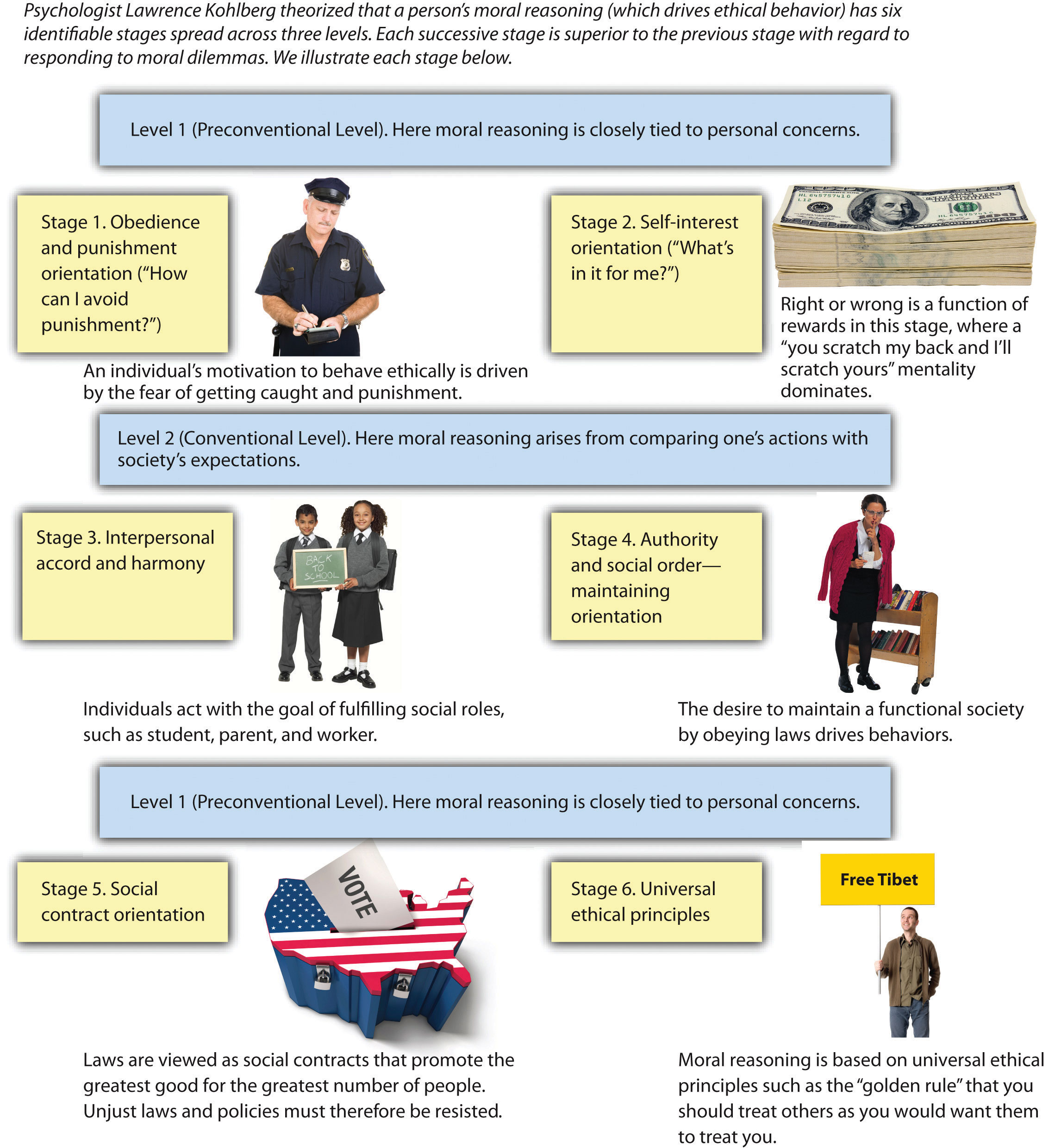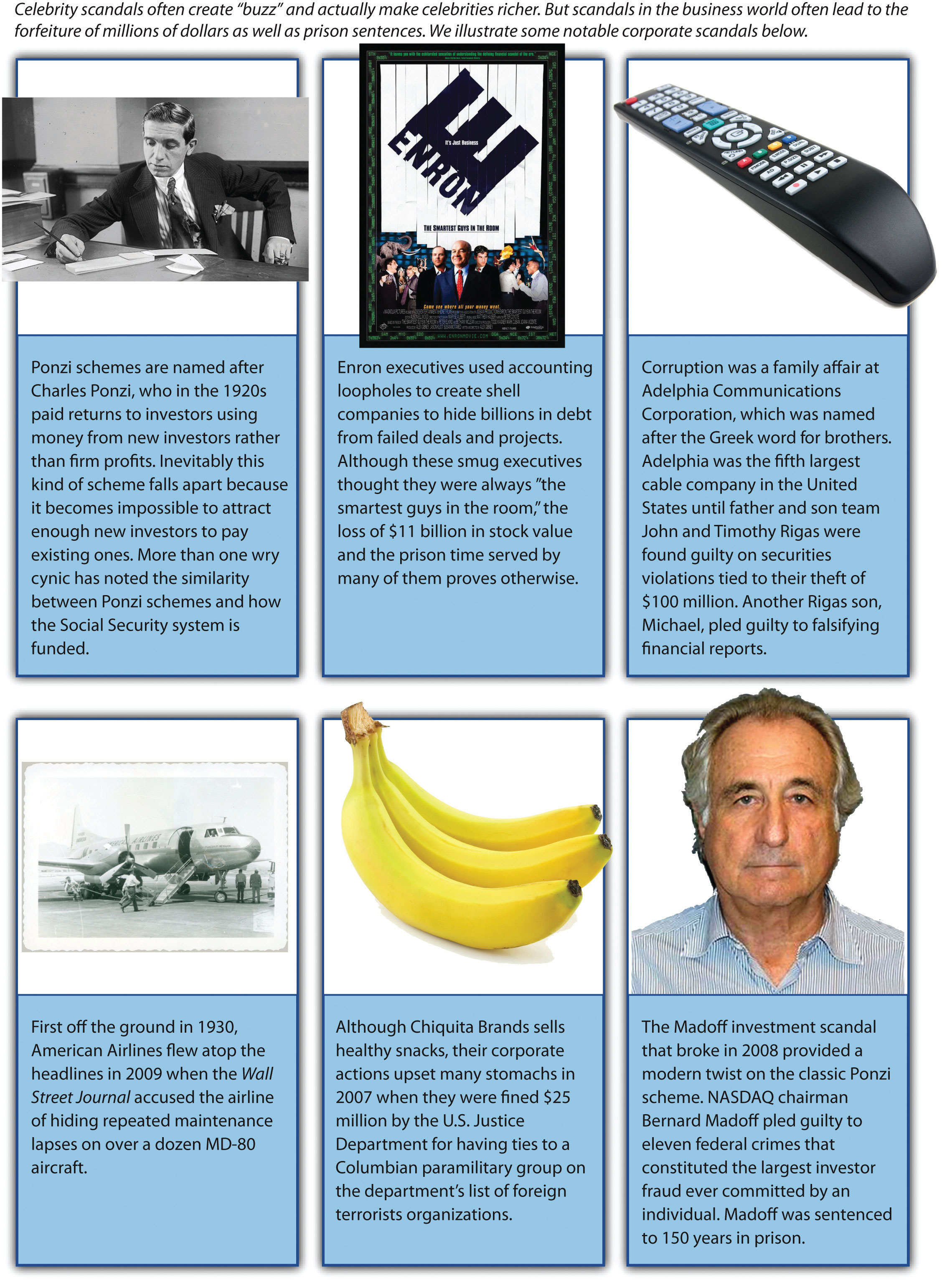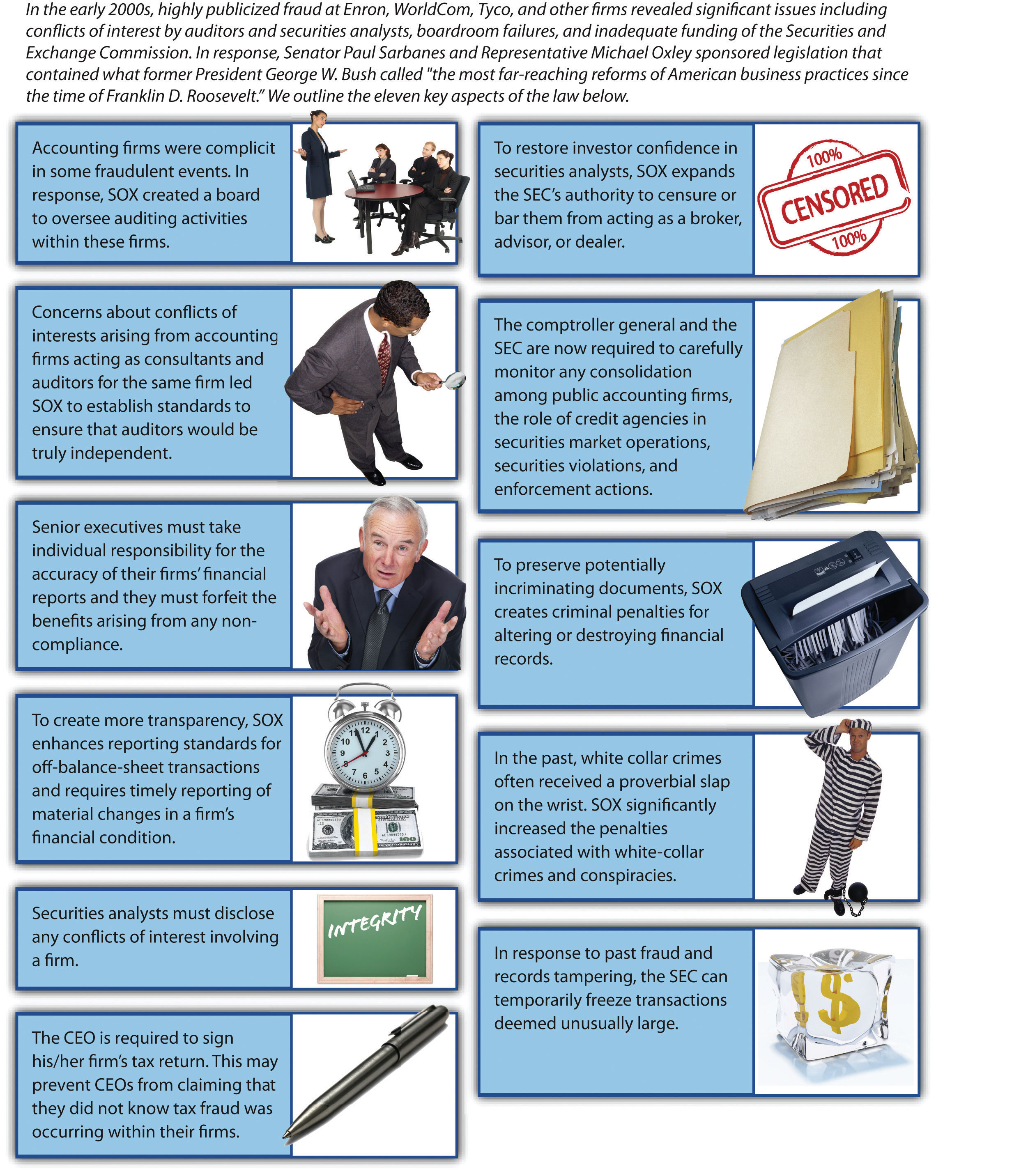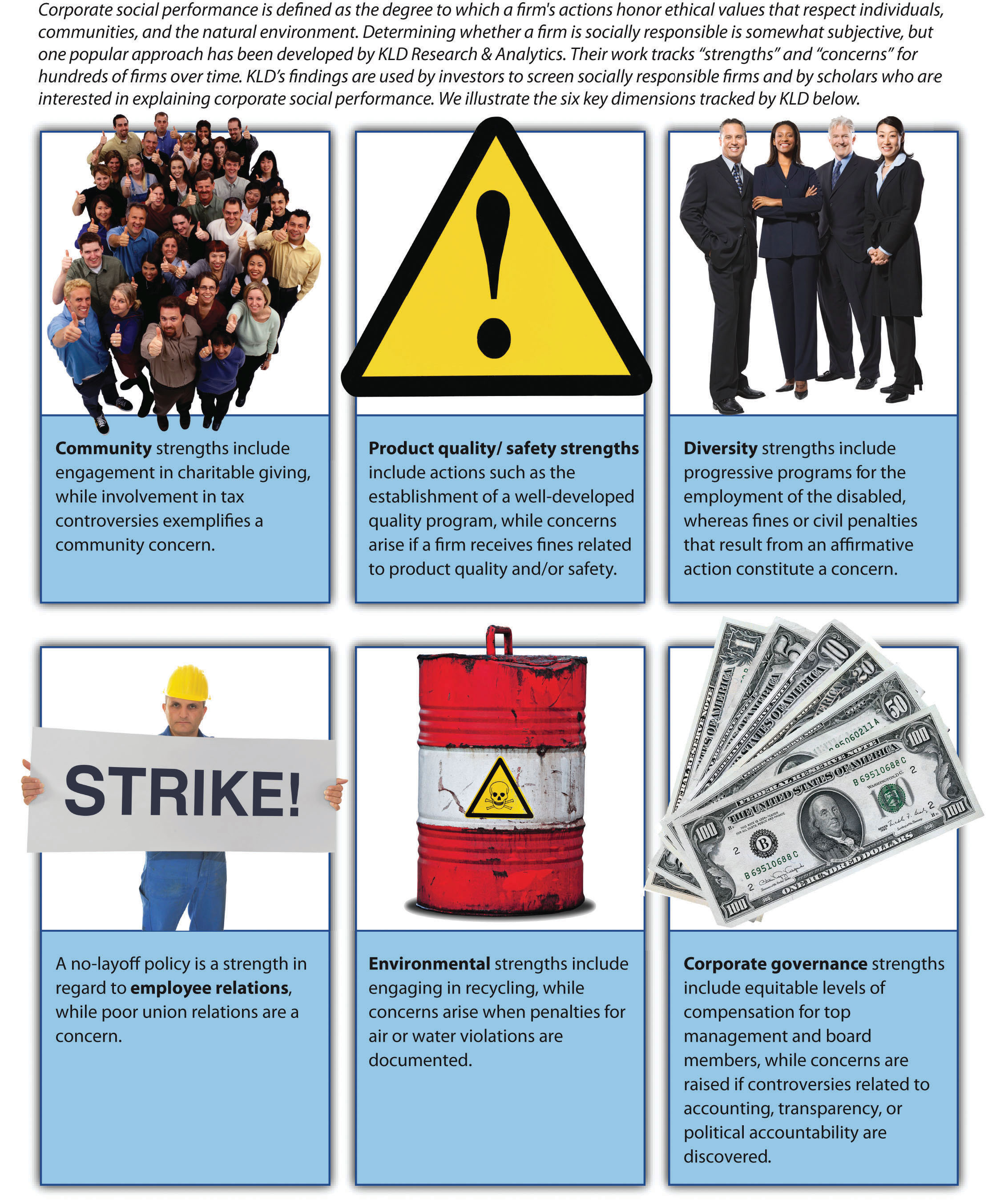This is “Corporate Ethics and Social Responsibility”, section 10.2 from the book Strategic Management: Evaluation and Execution (v. 1.0). For details on it (including licensing), click here.
For more information on the source of this book, or why it is available for free, please see the project's home page. You can browse or download additional books there. To download a .zip file containing this book to use offline, simply click here.
10.2 Corporate Ethics and Social Responsibility
Learning Objectives
- Know the three levels and six stages of moral development suggested by Kohlberg.
- Describe famous corporate scandals.
- Understand how the Sarbanes-Oxley Act of 2002 provides a check on corporate ethical behavior in the United States.
- Know the dimensions of corporate social performance tracked by KLD.
Stages of Moral Development
How do ethics evolve over time? Psychologist Lawrence Kohlberg suggests that there are six distinct stages of moral development and that some individuals move further along these stages than others.Kohlberg, L. 1981. Essays in moral development: Vol. 1. The philosophy of moral development. New York, NY: Harper & Row. Kohlberg’s six stages were grouped into three levels: (1) preconventional, (2) conventional, and (3) postconventional (Figure 10.4 "Stages of Moral Development").
The preconventional level of moral reasoning is very egocentric in nature, and moral reasoning is tied to personal concerns. In stage 1, individuals focus on the direct consequences that their actions will have—for example, worry about punishment or getting caught. In stage 2, right or wrong is defined by the reward stage, where a “what’s in it for me” mentality is seen.
In the conventional level of moral reasoning, morality is judged by comparing individuals’ actions with the expectations of society. In stage 3, individuals are conformity driven and act with the goal of fulfilling social roles. Parents that encourage their children to be good boys and girls use this form of moral guidance. In stage 4, the importance of obeying laws, social conventions, or other forms of authority to aid in maintaining a functional society is encouraged. You might witness encouragement under this stage when using a cell phone in a restaurant or when someone is chatting too loudly in a library.
The postconventional level, or principled level, occurs when morality is more than simply following social rules or norms. Stage 5 considers different values and opinions. Thus laws are viewed as social contracts that promote the greatest good for the greatest number of people. Following democratic principles or voting to determine an outcome is common when this stage of reasoning is invoked. In stage 6, moral reasoning is based on universal ethical principles. For example, the golden rule that you should do unto others as you would have them do unto you illustrates one such ethical principle. At this stage, laws are grounded in the idea of right and wrong. Thus individuals follow laws because they are just and not because they will be punished if caught or shunned by society. Consequently, with this stage there is an idea of civil disobedience that individuals have a duty to disobey unjust laws.
Figure 10.4 Stages of Moral Development

© Thinkstock
Corporate Scandals and Sarbanes-Oxley
Figure 10.5 Corporate Scandals

Images courtesy of Wikipedia, http://en.wikipedia.org/wiki/File:21rampell.xlarge1.jpg (top left); Hey Paul, http://www.flickr.com/photos/heypaul/117224100/ (top middle); anyjazz65, http://www.flickr.com/photos/49024304@N00/4427263275/ (bottom left); US Department of Justice, http://commons.wikimedia.org/wiki/File:BernardMadoff.jpg (bottom right); other images © Thinkstock.
In the 1990s and early 2000s, several corporate scandals were revealed in the United States that showed a lack of board vigilance. Perhaps the most famous involves Enron, whose executive antics were documented in the film The Smartest Guys in the Room. Enron used accounting loopholes to hide billions of dollars in failed deals. When their scandal was discovered, top management cashed out millions in stock options while preventing lower-level employees from selling their stock. The collective acts of Enron led many employees to lose all their retirement holdings, and many Enron execs were sentenced to prison.
In response to notable corporate scandals at Enron, WorldCom, Tyco, and other firms, Congress passed sweeping new legislation with the hopes of restoring investor confidence while preventing future scandals (Figure 10.5 "Corporate Scandals"). Signed into law by President George W. Bush in 2002, Sarbanes-OxleyLaw that set new or increased standards for the boards of public US companies and accounting firms. contained eleven aspects that represented some of the most far-reaching reforms since the presidency of Franklin Roosevelt. These reforms create improved standards that affect all publicly traded firms in the United States. The key elements of each aspect of the act are summarized as follows:
- Because accounting firms were implicated in corporate scandal, an oversight board was created to oversee auditing activities.
- Standards now exist to ensure auditors are truly independent and not subject to conflicts of interest in regard to the companies they represent.
- Enron executives claimed that they had no idea what was going on in their company, but Sarbanes-Oxley requires senior executives to take personal responsibility for the accuracy of financial statements.
- Enhanced reporting is now required to create more transparency in regard to a firm’s financial condition.
- Securities analysts must disclose potential conflicts of interest.
- To prevent CEOs from claiming tax fraud is present at their firms, CEOs must personally sign the firm’s tax return.
- The Securities and Exchange Commission (SEC) now has expanded authority to censor or bar securities analysts from acting as brokers, advisers, or dealers.
- Reports from the comptroller general are required to monitor any consolidations among public accounting firms, the role of credit agencies in securities market operations, securities violations, and enforcement actions.
- Criminal penalties now exist for altering or destroying financial records.
- Significant criminal penalties now exist for white-collar crimes.
- The SEC can freeze unusually large transactions if fraud is suspected.
The changes that encouraged the creation of Sarbanes-Oxley were so sweeping that comedian Jon Stewart quipped, “Did Wall Street have any rules before this? Can you just shoot a guy for looking at you wrong?” Despite the considerable merits of Sarbanes-Oxley, no legislation can provide a cure-all for corporate scandal (Figure 10.6 "Sarbanes-Oxley Act of 2002 (SOX)"). As evidence, the scandal by Bernard Madoff that broke in 2008 represented the largest investor fraud ever committed by an individual. But in contrast to some previous scandals that resulted in relatively minor punishments for their perpetrators, Madoff was sentenced to 150 years in prison.
Figure 10.6 Sarbanes-Oxley Act of 2002 (SOX)

© Thinkstock
Measuring Corporate Social Performance
TOMS Shoes’ commitment to donating a pair of shoes for every shoe sold illustrates the concept of social entrepreneurshipEntrepreneurial actions where both economic and social value creation occur., in which a business is created with a goal of bettering both business and society.Schectman, J. 2010. Good business. Newsweek, 156, 50. Firms such as TOMS exemplify a desire to improve corporate social performance (CSP)The degree to which a firm’s actions honor ethical values that respect individuals, communities, and the natural environment. in which a commitment to individuals, communities, and the natural environment is valued alongside the goal of creating economic value. Although determining the level of a firm’s social responsibility is subjective, this challenge has been addressed in detail by Kinder, Lydenberg and Domini & Co. (KLD), a Boston-based firm that rates firms on a number of stakeholder-related issues with the goal of measuring CSP. KLD conducts ongoing research on social, governance, and environmental performance metrics of publicly traded firms and reports such statistics to institutional investors. The KLD database provides ratings on numerous “strengths” and “concerns” for each firm along a number of dimensions associated with corporate social performance (Figure 10.7 "Measuring Corporate Social Performance"). The results of their assessment are used to develop the Domini social investments fund, which has performed at levels roughly equivalent to the S&P 500.
Figure 10.7 Measuring Corporate Social Performance

© Thinkstock
Assessing the community dimension of CSP is accomplished by assessing community strengths, such as charitable or innovative giving that supports housing, education, or relations with indigenous peoples, as well as charitable efforts worldwide, such as volunteer efforts or in-kind giving. A firm’s CSP rating is lowered when a firm is involved in tax controversies or other negative actions that affect the community, such as plant closings that can negatively affect property values.

Chick-fil-A encourages education through their program that has provided more than $25 million in financial aid to more than twenty-five thousand employees since 1973.
Image courtesy of SanFranAnnie, http://www.flickr.com/photos/sanfranannie/2472244829.
CSP diversity strengths are scored positively when the company is known for promoting women and minorities, especially for board membership and the CEO position. Employment of the disabled and the presence of family benefits such as child or elder care would also result in a positive score by KLD. Diversity concerns include fines or civil penalties in conjunction with an affirmative action or other diversity-related controversy. Lack of representation by women on top management positions—suggesting that a glass ceiling is present at a company—would also negatively impact scoring on this dimension.
The employee relations dimension of CSP gauges potential strengths such as notable union relations, profit sharing and employee stock-option plans, favorable retirement benefits, and positive health and safety programs noted by the US Occupational Health and Safety Administration. Employee relations concerns would be evident in poor union relations, as well as fines paid due to violations of health and safety standards. Substantial workforce reductions as well as concerns about adequate funding of pension plans also warrant concern for this dimension.
The environmental dimension records strengths by examining engagement in recycling, preventing pollution, or using alternative energies. KLD would also score a firm positively if profits derived from environmental products or services were a part of the company’s business. Environmental concerns such as penalties for hazardous waste, air, water, or other violations or actions such as the production of goods or services that could negatively impact the environment would reduce a firm’s CSP score.
Product quality/safety strengths exist when a firm has an established and/or recognized quality program; product quality safety concerns are evident when fines related to product quality and/or safety have been discovered or when a firm has been engaged in questionable marketing practices or paid fines related to antitrust practices or price fixing.
Corporate governance strengths are evident when lower levels of compensation for top management and board members exist, or when the firm owns considerable interest in another company rated favorably by KLD; corporate governance concerns arise when executive compensation is high or when controversies related to accounting, transparency, or political accountability exist.
Strategy at the Movies
Thank You for Smoking
Does smoking cigarettes cause lung cancer? Not necessarily, according to a fictitious lobbying group called the Academy of Tobacco Studies (ATS) depicted in Thank You for Smoking (2005). The ATS’s ability to rebuff the critics of smoking was provided by a three-headed monster of disinformation: scientist Erhardt Von Grupten Mundt who had been able to delay finding conclusive evidence of the harms of tobacco for thirty years, lawyers drafted from Ivy League institutions to fight against tobacco legislation, and a spin control division led by the smooth-talking Nick Naylor.
The ATS was a promotional powerhouse. In just one week, the ATS and its spin doctor Naylor distracted the American public by proposing a $50 million campaign against teen smoking, brokered a deal with a major motion picture producer to feature actors and actresses smoking after sex, and bribed a cancer-stricken advertising spokesman to keep quiet. But after the ATS’s transgressions were revealed and cigarette companies were forced to settle a long-standing class-action lawsuit for $246 billion, the ATS was shut down. Although few organizations promote a product as harmful as cigarettes, the lessons offered in Thank You for Smoking have wide application. In particular, the film highlights that choosing between ethical and unethical business practices is not only a moral issue, but it can also determine whether an organization prospers or dies.

In Thank You for Smoking, lobbyist Nick Naylor faces the difficult task of making smoking sexy in an era when the health hazards of this practice are well known.
© Thinkstock
Key Takeaway
- The work of Lawrence Kohlberg examines how individuals can progress in their stages of moral development. Lack of such development by many CEOs led to a number of scandals, as well as legislation such as the Sarbanes-Oxley Act of 2002 that was enacted with the hope of deterring scandalous behavior in the future. Firms such as KLD provide objective measures of both positive and negative actions related to corporate social performance.
Exercises
- How would your college or university fare if rated on the dimensions used by KLD?
- Do you believe that executives will become more ethical based on legislation such as Sarbanes-Oxley?




